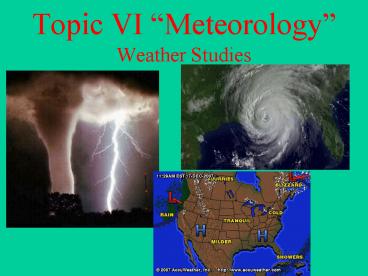Topic VI - PowerPoint PPT Presentation
1 / 24
Title: Topic VI
1
Topic VI Meteorology
- Weather Studies
2
I. Moisture in the Atmosphere the primary source
of energy for the water cycle is the Sun. It
unevenly heats Earths surface.
- A. Phases of the Water Cycle
- 1. Evaporation liquid to gas. Requires energy
making it a cooling process. - 2. Condensation gas (water vapor) to a liquid.
Releases energy into the air.
3
3. Transpiration the releasing of water in the
air by plants.
- 4. Precipitation the falling of liquid or solid
water from clouds. - Ex. Rain, sleet, snow and hail.
4
B. Factors Affecting Evaporation Rate
- 1. Temp. as temp. inc. evap. rate inc.
- 2. Humidity as humidity inc. evap. rate
decreases. - 3. Wind as wind inc. evap. rate inc.
- 4. Surface Area as surface area inc. evap. rate
increases.
5
C. Relative Humidity a comparison between the
amount of moisture in the air with the amount
that the air can hold at that temp.
- Dewpoint Temp. the temp. at which condensation
occurs. - dew drops of water forming on a cool surface.
- frost water vapor freezes (sublimates) on a
frozen surface.
6
2. Sling Psychrometer instrument used to
determine the dewpoint temp. and relative
humidity.
- 3. Steps to determine Dewpoint
- a. Find dry bulb temp.
- b. Find the diff. Between the wet and dry bulb
temps. - c. Use the chart on page 12 of the ref. Table.
7
D. Clouds collection of tiny water droplets or
ice crystals suspended in the atmosphere.
- 1. Cloud Formation
- a. Warm moist air rises.
- b. Air cools below dewpoint temp. and droplets
form around condensation nuclei (dust/salts).
8
2. Cloud Types
- a. Cumulus big puffy white clouds.
- b. Cirrus whispy ice crystals high in the
atmosphere. - c. Stratus low clouds that blanket the sky.
9
II. Air Pressure the force/weight of air pushing
on a surface. Air pressure pushes in all
directions equally. Pg. 13 ref. Table.
- A. Barometer instrument used to measure air
pressure. - As air pressure increases, the barometer rises.
10
B. Factors Affecting Air Pressure
- 1. Temperature as temp. increases, air pressure
decreases. - 2. Altitude as altitude increases, air pressure
decreases. - 3. Humidity as humidity increases, air pressure
decreases.
11
C. Winds caused by differences in air pressure.
The greater the difference (gradient) the
stronger the winds.
- 1. Isobars connect points of equal air pressure.
- the closer the isobars the stronger the winds.
12
D. Local Breezes smaller horizontal movement of
air .
- 1. Sea breeze air flows from the sea to the
land. - cooler air (high pressure) over the sea, flows
towards warmer air (low pressure) over the land.
13
2. Land breeze air flows from the land to the
sea.
- Air over the land cools at night and flows
towards the warmer air over the water.
14
E. Wind Direction flow from regions of high to
low pressure and named for the direction they
come from.
- 1. Cyclone (low pressure) winds blow
counterclockwise towards the middle. - 2. Anticyclone (high pressure) winds blow
clockwise and out.
15
F. Global Winds caused by the unequal heating of
earths surface. Page 14 ref. Table.
- 1. Diverging zones cool, dry high pressure air
sinks at the poles and 300 lat. - 2. Converging zones warm, moist low pressure air
rises at the equator and 600 lat.
16
III. Air Masses large masses of air that have a
characteristic temp. and moisture of their source
region. Page 13 ref. table.
- A. Source Regions
- 1. Maritime formed over water. (moist)
- 2. Continental formed over land. (dry)
- 3. Polar cool air from high latitudes
- 4. Tropical warm air from low latitudes.
17
IV. Front the boundary that separates two
different air masses. Pg. 13 ref.
- A. Types of Fronts
- 1. Cold Front dense cold air forces warm moist
air upward creating heavy precipitation for short
periods of time at the frontal boundary.
18
2. Warm Front warm air slowly rises over cold
air producing long periods of light precipitation
ahead of the frontal boundary.
19
3. Occluded Front a fast moving cold front over
takes a slower warm front causing clouds and
precipitation.
20
4. Stationary Front cold and warm air masses
near each other with neither advancing causing
long periods of light precipitation.
21
B. Synoptic Weather Maps show weather conditions
on a national or global basis.
- 1. Storm Tracks most storm systems move from
west to east across the U.S.
22
V. Severe Weather
- A. Hurricanes a large rotating storm of tropical
origin. - they get their energy from warm water. Once
they hit land they lose energy.
23
Hurricane Eye
24
B Tornadoes caused by the collision of warm,
moist air with cold, dry air. Winds can exceed
370 mph.
- C. Storm Safety
- 1. Stay indoors
- 2. Store food/water
- 3. Have batteries/flashlights
- 4. Have a radio

